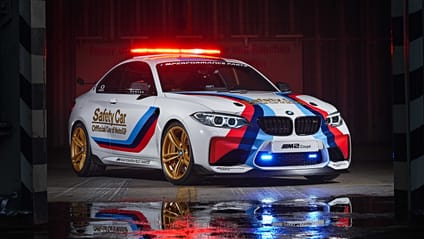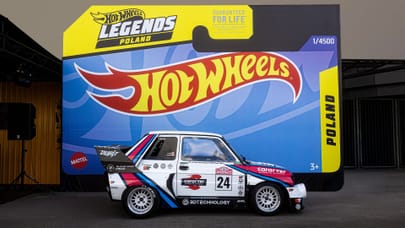
Here’s how BMW turned the M2 into a safety car
New MotoGP safety car unveiled. Here's how BMW made it


This is the brand new BMW M2 MotoGP safety car. As the name suggests, it will appear throughout the 2016 MotoGP season, sharing duties with the water-injected M4 Coupe, and an M3 too.
And it took BMW just over two months to build.
We’ll come to that shortly. Though the partnership between BMW and MotoGP stretches back to 1999, M Division took on official safety car duties in 2006. There have been some significant debuts during that time, too: the BMW M6 Gran Coupe arrived as a safety car in 2013, while the water-injected BMW M4 was a feature in 2015.
This year of course, we get the brand new M2 Coupe, a car we’re rather looking forward to. Unveiled earlier this year at the Detroit Motor Show, it boasts a 3.0-litre turbo straight-six engine, possessing 365bhp and 369lb ft of torque and good for a 0-62mph time of 4.3 seconds and a top speed of 155mph.
For its duties as a safety car however, BMW’s M Division gave it a few tweaks. Last October, engineers began modifying and hand-preparing the M2. Ten weeks later, they had finished.
Here’s how they did it...
Advertisement - Page continues belowThey removed all of the rear and fitted a roll cage

The first job was to bin the rear seats, carpet and all associated bits, to ‘free up the undercarriage’. This was to facilitate the welding of a roll cage and six-point harness into place, along with the bracket for the fire extinguisher. Then some carpet was laid over to make it look pretty.
The cage? It was based on the one you'll find in the BMW M4 GTS, here adapted to fit the slightly smaller M2.
A light bar was added…

It’s an LED unit, and is controlled via a specially developed control panel in the cockpit. The crew can select various lighting programmes and flashes for the full Disco Stu effect.
Oh, and there are also a set of blue lights in the front grille, and red lamps in place of the rear reverse lights.
Advertisement - Page continues below…as well as a giant, excellent rear wing

The addition of a light bar affects the aero of the M2. So M Division fluid dynamic experts were called in to assist. A suitable counter-measure? The fitment of an adjustable, carbonfibre reinforced plastic rear wing, which removes lift on the rear axle.
It also looks superb.
The front was also optimised for aero

“The entire chassis functions as one aerodynamic unit,” explains BMW. Hence the addition of a modified front skirt. A new adapter and splitter were both integrated into the front, comprising of glass fibre laminate and carbonfibre inlays.
They fitted better lightweight brakes...

Engineers used the M Performance coilover suspension and slotted Michelin Cup tyres onto those rather delightful gold wheels, which shroud carbon-ceramic brakes from the BMW M3 and BMW M4.
...and a really, really loud exhaust

The exhaust – another M Performance part – was fitted, but here ‘stripped down completely’. Which means it doesn’t feature a silencer, or catalytic converter, or flap system. Which also means noise.
How much noise? All of it, apparently. “The BMW M2 MotoGP safety car can still be heard over the prototype motorcycles on their installation lap,” explains BMW. YES.
The engine remains the same, turbocharged 3.0-litre six-pot with 365bhp, mind. There’s a new bonnet latch, as well as battery master switch and fuel suction pump, too.
Advertisement - Page continues belowThe interior and exterior were treated to some fine detailing

Many of the interior parts were retrimmed in Alcantara or leather, while prototype parts feature in gold. Parts like the wheels, roll cage, brake calipers, rear wing mounts, seat brackets, steering wheel spokes and contrast stitching.
Even the badge is gold. And all this for a safety car.
How’s the finished article look? Click the right arrow to find out…
BMW M2 MotoGP safety car

Engine: 3.0-litre in-line six-cylinder engine
Power: 365bhp, 369lb ft
Acceleration: 0-62mph 4.3s (with auto, 4.5s manual)
Top speed: 155mph (limited)Advertisement - Page continues belowBMW M2 MotoGP safety car

Engine: 3.0-litre in-line six-cylinder engine
Power: 365bhp, 369lb ft
Acceleration: 0-62mph 4.3s (with auto, 4.5s manual)
Top speed: 155mph (limited)BMW M2 MotoGP safety car

Engine: 3.0-litre in-line six-cylinder engine
Power: 365bhp, 369lb ft
Acceleration: 0-62mph 4.3s (with auto, 4.5s manual)
Top speed: 155mph (limited)BMW M2 MotoGP safety car

Engine: 3.0-litre in-line six-cylinder engine
Power: 365bhp, 369lb ft
Acceleration: 0-62mph 4.3s (with auto, 4.5s manual)
Top speed: 155mph (limited)BMW M2 MotoGP safety car

Engine: 3.0-litre in-line six-cylinder engine
Power: 365bhp, 369lb ft
Acceleration: 0-62mph 4.3s (with auto, 4.5s manual)
Top speed: 155mph (limited)
Trending this week
- Car Review
BMW 1 Series
- Top Gear's Top 9
Nine dreadful bits of 'homeware' made by carmakers







